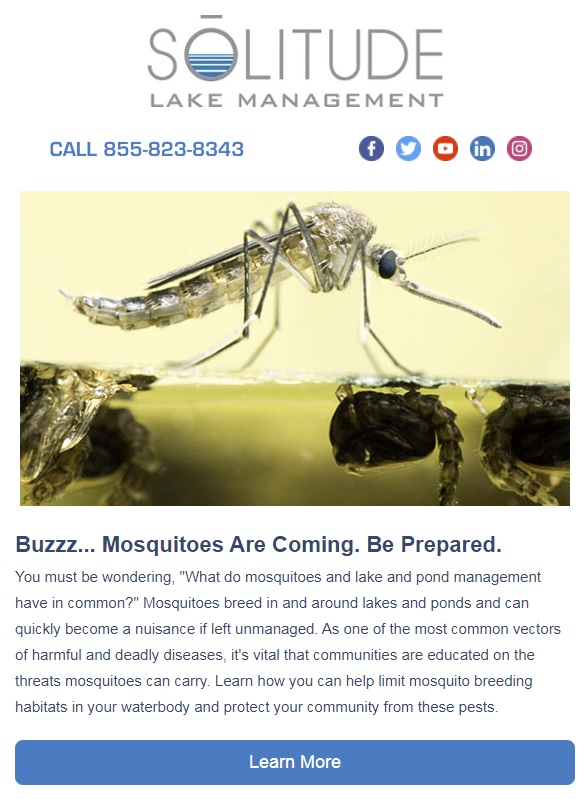Mosquitoes Are Coming. Be Prepared.
Tips To Reduce Mosquitoes & Disease In Your Community
We welcome longer days and warmer weather, but mosquitoes are part of the deal. Unless you’re one of the lucky few who these pesky insects don’t bother, it can be challenging to avoid them. And, unfortunately, itchy bites aren’t the only effect mosquitoes can have – they are also the most common vectors of harmful and sometimes deadly diseases, including West Nile virus, Malaria, Chikungunya, and Zika virus.
Cold-blooded mosquitoes thrive in warmer temperatures and can get dangerously out of hand without proper management. To protect yourself during outdoor activities all summer long, consider these simple, natural, and effective ways to limit their impact.

Eliminate Breeding Habitats
Throughout her six- to eight-week lifespan, a female mosquito will lay about 300 eggs, often in standing or stagnant water. Clearing gutters, picking up litter, and emptying buckets and small outdoor containers can help decrease the number of available habitats for mosquitoes to reproduce and thrive. And don’t forget to educate family and neighbors to do the same.

Circulate Stagnant Lakes & Ponds
In aquatic environments such as lakes, ponds, and stormwater basins, the introduction of a floating fountain or submersed aeration system can help consistently circulate warm, stagnant water to create unfit mosquito breeding grounds. Simultaneously, these systems can help impede the growth of algae and nuisance weeds by supporting ideal water quality conditions.

Treat Undesirable Aquatic Plants
Stagnant water pockets in ponds can also be eliminated through the removal of phragmites and non-beneficial floating and emergent vegetation. Effective solutions may include mechanical harvesting, hand-pulling, or highly-targeted herbicides, to name a few. Your aquatic specialist can help you identify the appropriate option for your waterbody.

Plant Vegetation That Attracts Dragonflies
Dragonflies can feed on hundreds of larvae and full-grown mosquitoes each day. The introduction of native, beneficial vegetation around your pond, like blue flag iris, pickerelweed, arrowhead, spatterdock, lizard’s tail, and various types of rushes and sedges can help attract predator dragonflies to your property.

Stock Fish That Feed On Mosquito Larvae
Stocking a lake or pond annually with fathead minnows, bluegill, and mosquitofish can help prevent mosquito larvae and adult mosquito infestations throughout the summer. Check with an experienced fisheries biologist about your state’s specific stocking regulations.

Integrate Sustainable Biological Larvicides
If the above natural management methods aren’t making enough of an impact on pesky mosquito populations, a safe EPA-registered biological larvicide or insecticide may be used. When applied by a professional, either via ground services, drones, or even aerial fleets, this method is extremely safe and effective.
Consider A Proactive Comprehensive Management Plan
An Integrated Mosquito Management (IMM) program leverages science, technology, and strategic, environmentally responsible applications to target the insect through each phase of its lifecycle. Thorough site assessments, surveillance, and disease monitoring are all a crucial part of a successful mosquito management program.
It’s critical for communities to understand the threats posed by mosquitoes, educate their residents, and implement a preventative management plan before peak mosquito season arrives. Now that the days are getting longer and warmer, take some time to prepare for a mosquito problem before mid-summer hits—your bare skin will thank you!
Discover more from SFPMA
Subscribe to get the latest posts sent to your email.


